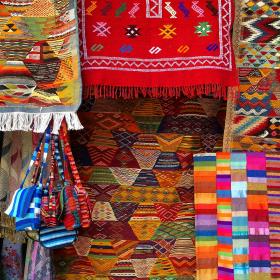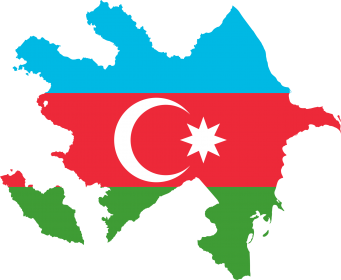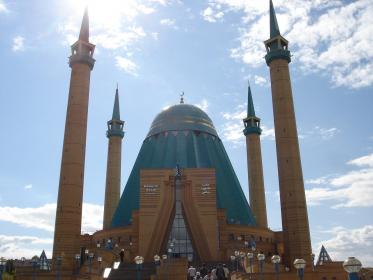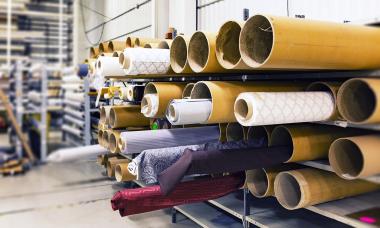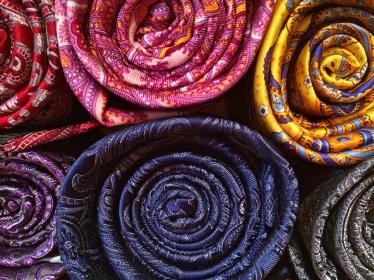AZERBAIJAN'S TEXTILE AND SILK PRODUCTION IS ABOUT TO RESTART
- Industrial park under construction
Baku (GTAI) - The Azerbaijani textile and silk industry is going to have a future again after a dramatic slump. Several initiatives are helping the traditional industry to make a fresh start.
Azerbaijan wants to revive its once strong textile, silk and clothing industry. In 1990, the sector still accounted for just under 18 percent of the total industrial production – in 2017 it was just 0.5 percent. Future investment activities will be determined by several initiatives. These include the implementation of programs for the production and processing of cotton and silk cocoons for semi-finished and finished goods, the establishment of an industrial park for light industry in Mingatchevir and the establishment of branches of the Azerkhalcha company for hand-woven carpets.
New projects in cotton processing on the horizon
At the beginning of the 1980s, cotton cultivation boomed in the country with an annual harvest of more than 1 million tons of raw cotton. The collapse of the Soviet Union, the transformation crisis in the 1990s and general neglect almost brought the industry to a standstill. In 2015, the harvest reached a historic low of 35,000 tons of raw cotton.
But the turnaround has begun. In 2017, 207,000 tons of raw cotton were harvested (forecast for 2018: 250,000 to 260,000 tons). A downer is the low average yield of 1.52 tons per hectare (2017). The government announced increased support for soil irrigation and technical equipment for manufacturers. By 2022 the harvest is expected to rise up to 500,000 tons per year.
The "State Program for the Development of Cotton Growing in the period 2017 to 2022" adopted on July 13th 2017 is a guideline for the further development. Projects are planned for the renewal of existing and the construction of new cotton ginning mills and processing of cotton fibers into yarns, fabrics and finished products. By mid-2018 there were eight spinning mills in the country with a total annual capacity of 44,600 tons of yarn. Above all among the yarn producers in Uzbekistan are the companies Mingatschewir Textil, MKT Istehsalat Kommersiya, ASK Textil Sumgait and Azeripek (better known as Ipek Scheki).
Silk industry to be expanded
Since 2016 the silk industry, which came almost to a standstill, has now been on the move again. On November 27th 2017 the "State Program for the Development of Silkworm Breeding and Processing of Mulberry Silkworm Cocoons for the period 2017 to 2025" was adopted. The program defines projects to revitalize the sector. The annual production of cocoons is expected to rise to 6,000 tons by 2025, ensuring an annual production of up to 600 tons of raw silk. In 2017 244 tons of cocoons were produced after 71 tons in 2016 (forecasts for 2018 and 2019: about 500 and 1,000 tons respectively).
The modernization of the silk combinate Azeripek in Scheki is at the top of the project list. The contact organization is the Azerbaijan State Industrial Association, to which Azeripek and other companies are reporting (http://www.ask.gov.az). The construction of a new silk spinning mill with an annual capacity of 3,000 tons of yarn is planned.
Established in 1931 and later expanded the Silk Combine in Scheki was the flagship of the silk industry in the Soviet Union in the 1970s and 1980s with some 7,000 permanent employees. It produced up to 400 tons of raw silk per year and supplied over 100 factories with silk yarn and twist. Inefficient privatization, financial problems, lack of raw materials and sales difficulties repeatedly led to production stoppages. Today's capacities allow an annual production of up to 135 tons of raw silk only. As a result of technical problems, the factory is unable to produce finished fabrics.
Industrial park for light industry under construction
In the in 2016 established Industrial Park for Light Industry in Mingatchevir, nine factories for the production of textile and clothing products (cotton, acrylic and wool yarn, hosiery and apparel) and other light industry products (leather footwear and cosmetics) are to be built. The construction of more production facilities is planned. In February 2018 the company Textile Mingatchevir opened the first two factories in the industrial park. It intends to produce up to 20,000 tons of cotton and blended yarn annually. Capital expenditures were USD 46 million.
Azerkhalcha revives traditional carpet art
Azerkhalcha, the company for the production of hand-woven carpets, has an ambitious goal: 30 regional carpet weaving mills are to be established by 2020. By the end of 2017 ten branches have already been opened. A further 20 will be added in 2018 and 2019. Azerkhalcha was founded in 2016 on the initiative of the government. In 2018 and 2019, the state will invest around USD 22 million in the construction of new branches and a wool processing factory.
From 2020, approximately 5,000 employees will produce hand-woven carpets under the Azerbaijan Carpet label for domestic and foreign markets. The expansion plans for the production of hand-woven carpets result from the in 2018 adopted state program for the development of carpet art in Azerbaijan and the Nakhichevan Autonomous Republic for the years 2018 till 2022.
Azerbaijan offers opportunities as a production location
Azerbaijan can score with some advantages as a production location for the textile and silk industry as well as for the clothing industry. These include a sufficiently available and quickly trained labor force, low wage costs, tax and other preferences in industrial areas and good conditions for the sale of the goods.
Good sales opportunities result from the free trade agreements with the countries of the Commonwealth of Independent States and the export opportunities to Turkey. No import duties have to be paid for exports to these countries. Clothing manufacturers from EU countries with the intention of exporting to these countries can benefit from this. Several companies, especially from the Baltic States, are currently exploring their opportunities for a market entry.
The Azerbaijan Textile Industry Association sees a need for action on the part of the government with regard to the framework conditions for the domestic clothing manufacturers. For example, the tariff burden on imports of accessories such as adhesives, buttons and snap fasteners and zippers should significantly be reduced.
Leading manufacturers of apparel and other finished textile products include Baku Textile Factory (Baki Tekstil Fabriki), Accord Textil (Agstafa, part of the Accord Industrial Holding), Alyans Tekstil (Sumqayit), the apparel factory in the Gilan-Textile Park (Sumqayit), and Debet Uniform (Baku). The factories mainly produce workwear and outerwear.
Uwe Stohbach, Germany Trade & Invest
www.gtai.de



